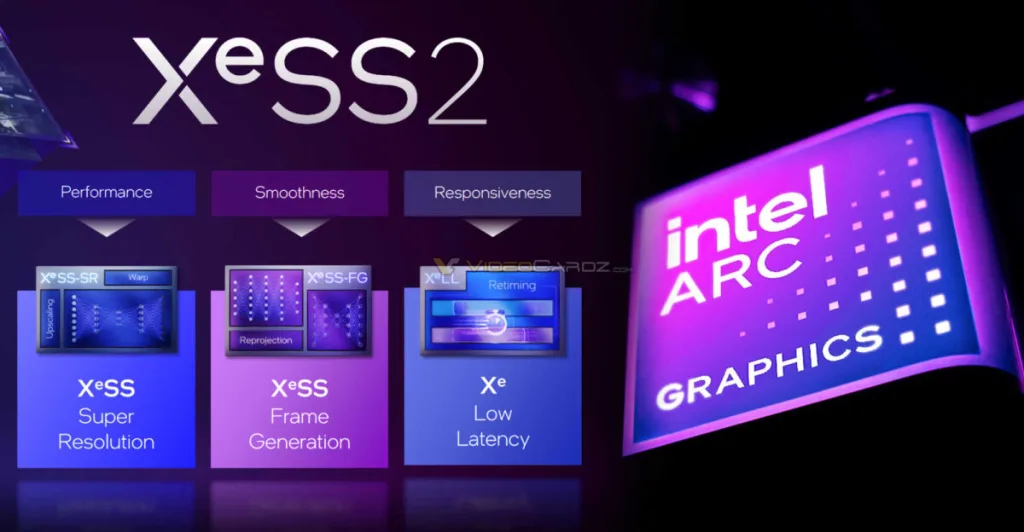Intel XeSS 2 SDK: The gaming industry is undergoing a revolution, with AI-powered upscaling and frame generation leading the charge. Intel has taken a significant leap forward with the release of the XeSS 2 SDK (Xe Super Sampling 2)—an advanced frame generation and upscaling tool designed to enhance gaming visuals and performance.
Since its initial announcement, gamers, developers, and hardware enthusiasts have eagerly awaited this release. Many wondered why Intel’s XeSS technology took longer than expected to roll out, especially when competitors like NVIDIA’s DLSS (Deep Learning Super Sampling) and AMD’s FSR (FidelityFX Super Resolution) have been dominating the scene. Now, with the official launch of XeSS 2, Intel aims to level the playing field by offering higher frame rates, reduced latency, and superior visual fidelity—all powered by AI-driven enhancements.
So, what makes XeSS 2 SDK a breakthrough? How does it compare to DLSS and FSR? And why should developers and gamers care about this new release? Let’s break it all down.
Table of Contents

What is XeSS 2 SDK?
The XeSS 2 Software Development Kit (SDK) is an AI-based graphics technology that boosts gaming performance by improving frame generation and AI-powered upscaling. This means smoother gameplay, higher frame rates, and better image quality, even on lower-end hardware.
It consists of three core components:
✅ 1. XeSS Super Resolution (XeSS-SR)
- Boosts frame rates on all GPUs that support Shader Model 6.4 (DP4A).
- Uses AI-based upscaling to improve image quality without demanding extra GPU power.
- Works across Intel Arc GPUs and other compatible hardware.
✅ 2. XeSS Frame Generation (XeSS-FG)
- Uses AI to generate extra frames, improving smoothness and responsiveness.
- Designed for Intel Arc GPUs with Xe Matrix Extensions (XMX) for higher efficiency.
- Similar to NVIDIA’s DLSS 3 Frame Generation, reducing motion blur and enhancing real-time rendering.
✅ 3. Xe Low Latency (XeLL)
- Minimizes input lag, making gameplay more responsive.
- Ensures a seamless gaming experience, especially for fast-paced FPS and esports titles.
- Available on both discrete and integrated Intel Arc GPUs.
Together, these technologies allow developers to integrate faster, AI-enhanced graphics into their games, making gameplay smoother and more immersive for users.

How Does XeSS 2 Compare to DLSS & FSR?
Intel’s XeSS 2 enters a competitive field dominated by NVIDIA DLSS and AMD FSR. Each technology aims to enhance gaming performance while maintaining high visual fidelity. But how does XeSS 2 stand out?
| Feature | Intel XeSS 2 | NVIDIA DLSS 3 | AMD FSR 3 |
|---|---|---|---|
| Upscaling Method | AI-Based (Super Resolution) | AI-Based (Deep Learning) | Spatial & Temporal Upscaling |
| Frame Generation | AI-Generated Frames (XeSS-FG) | AI-Based Frame Interpolation | Fluid Motion Frames |
| Hardware Support | Works on Intel Arc & some non-Intel GPUs | Requires RTX 4000 series GPUs | Works on all GPUs |
| Latency Reduction | Xe Low Latency (XeLL) | NVIDIA Reflex | AMD Anti-Lag |
| Integration | Available for Unreal & Unity Engines | Limited to NVIDIA GPUs | Broad compatibility |
Key Takeaways:
✅ XeSS 2 brings AI-driven upscaling similar to DLSS but is more widely accessible.
✅ Unlike DLSS 3, which is locked to RTX 4000 GPUs, XeSS 2 supports more hardware.
✅ Xe Low Latency (XeLL) is Intel’s answer to NVIDIA Reflex and AMD Anti-Lag.
While NVIDIA still leads in AI-driven upscaling, Intel’s broader compatibility and AI-based frame generation give it an edge for developers seeking wider adoption.
Why XeSS 2 is a Game-Changer for Developers
For game developers, XeSS 2 simplifies integration and allows for high-quality rendering without the need for high-end GPUs. Here’s why developers should pay attention:
🔹 1. Seamless Integration into Unreal & Unity Engines
Intel has released XeSS 2 SDK plugins for Unreal Engine (4 & 5) and Unity Engine, enabling:
✔️ Faster implementation into new games.
✔️ No need for complex coding—easier optimization.
✔️ Enhanced performance on Intel Arc GPUs.
🔹 2. AI-Powered Performance Boost
- Developers can maximize frame rates without requiring players to upgrade their hardware.
- Works across multiple GPU architectures, ensuring wider compatibility.
- Ideal for both AAA and indie developers looking to enhance graphics performance.
🔹 3. Real-Time Rendering for a Better Player Experience
- XeLL minimizes input lag, improving reaction times for esports players.
- AI-generated frames create smoother animations and transitions.
- Optimized for DirectX 12 & Vulkan, allowing games to run at higher frame rates.
These features make XeSS 2 a critical tool for studios looking to future-proof their games without compromising on quality.

How Gamers Benefit from XeSS 2
For gamers, XeSS 2 is all about performance, visuals, and responsiveness.
🎮 1. Higher FPS Without Upgrading Hardware
- AI-driven upscaling means you don’t need to buy an expensive GPU to get higher FPS.
- Works on non-Intel GPUs as well, increasing accessibility.
🎮 2. Smoother Gameplay with AI Frame Generation
- Frame Generation (XeSS-FG) makes games feel silky smooth, reducing stuttering.
- Great for fast-paced shooters, racing, and open-world games.
🎮 3. Reduced Input Lag for Competitive Gaming
- Xe Low Latency (XeLL) improves response time, crucial for esports and online gaming.
- Competitive gamers can expect snappier movement and precision aiming.
In short, XeSS 2 gives gamers better graphics and performance without requiring high-end RTX 4000 or RX 7000 series GPUs.
What’s Next for XeSS 2?
With the launch of XeSS 2 SDK, Intel is positioning itself as a major player in AI-powered gaming graphics. Here’s what the future holds:
🔹 Broader Game Integration – More developers adopting XeSS 2 for AAA & indie games.
🔹 Optimizations for Future GPUs – Intel’s Battlemage GPUs will leverage XeSS 2 for next-gen gaming.
🔹 Expansion to Consoles? – Intel may expand XeSS to console gaming, competing with PlayStation & Xbox upscaling tech.
Intel’s commitment to AI-driven gaming suggests XeSS 2 will evolve into an even more powerful tool.
Final Thoughts: Is XeSS 2 the Future of AI Gaming?
With AI-powered upscaling and frame generation, Intel’s XeSS 2 SDK is set to redefine gaming performance.
✅ For Developers: Easier integration into Unreal & Unity, with AI-based enhancements.
✅ For Gamers: Higher FPS, better visuals, and reduced latency—without expensive upgrades.
✅ For the Future: More games adopting XeSS 2, pushing AI-powered gaming further.
As AI continues shaping the future of gaming, Intel’s XeSS 2 SDK is a major step forward. Whether you’re a gamer, developer, or tech enthusiast, this is a technology to watch!








